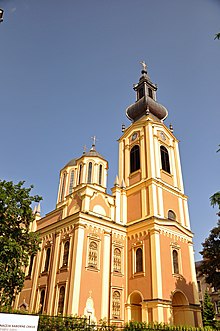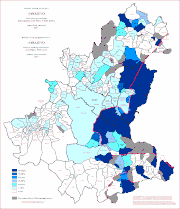Serbs in Sarajevo
| Part of a series on |
| Serbs |
|---|
 |
Serbs in Sarajevo numbered 157,526 according to the 1991 census, making up more than 30% of the ten pre-war municipalities of the Sarajevo metropolitan area: Centar, Stari Grad, Novo Sarajevo, Novi Grad, Ilidža, Ilijaš, Vogošća, Hadžići, Trnovo, and Pale.
Today, following the Bosnian War, few Serbs remain in central areas of Sarajevo. Most have moved abroad (to Serbia or other countries), or to East Sarajevo (previously Srpsko Sarajevo - Serbian Sarajevo), a new city on the outskirts of Sarajevo located in Republika Srpska. Many parts of the pre-war Sarajevo metropolitan area are in East Sarajevo: Pale, East Ilidža, East Novo Sarajevo, Trnovo, and East Stari Grad.
History
[edit]World War I
[edit]After the assassination of Archduke Franz Ferdinand of Austria and Sophie, Duchess of Hohenberg, Anti-Serb rioting took place in Sarajevo on 28 and 29 June 1914, incited by Austro-Hungarian authorities.[1][2] Two Serbs, Pero Prijavić and Nikola Nožičić, died some days later as a result of the injuries they sustained after they were beaten and a total of fifty people were treated at Sarajevo hospitals following the two-day rioting.[3] Whole stocks of goods as well as monies from Serb shops and homes were gone due to the plundering. The devastation left a profound impact on Serb-owned business and industry given the minority Sarajevo Serb population's prominence in those areas.[3]
World War II
[edit]During WWII, Serbs living in the Independent State of Croatia (NDH), a German-installed puppet state, were subjected to genocide by the Croatian fascist Ustaše regime. In the summer of 1941, Ustaše militia periodically interned and executed groups of Sarajevo Serbs. In August 1941, they arrested about one hundred Serbs suspected of ties to the resistance armies, mostly church officials and members of the intelligentsia, and executed them or deported them to concentration camps.[4] The Ustaše killed at least 323 people in the Villa Luburić, a slaughter house and place for torturing and imprisoning Serbs, Jews and political dissidents.[5]
Bosnian war
[edit]On 1 March 1992, a Bosnian Serb wedding procession in Sarajevo's Baščaršija quarters was attacked, resulting in the shooting death of the father of the groom, Nikola Gardović, and the wounding of a Serbian Orthodox priest. The attack took place on the last day of a controversial referendum on Bosnia and Herzegovina's independence from Yugoslavia, in the early stages of the breakup of Yugoslavia and the Yugoslav Wars.[6] Gardović, an ethnic Serb, is often regarded as the first casualty of the Bosnian war.[7]
During the siege of Sarajevo, Bosniak paramilitary leader Mušan Topalović and his forces abducted and killed mostly Serbs living in and around Sarajevo before Bosnian police killed Topalović in October 1993.[8] A pit on the outskirts of the city was used as an execution site and a mass grave for Serbs who were rounded up, beaten and killed, sometimes by having their throats slit and decapitated.[9][10] The total number of victims killed is not known, with estimates ranging from a few dozen to some hundreds.[11] The actions of paramilitary units led many thousands of Serbs to flee the city, particularly in the summer of 1992.[12] By war's end, the number of Serbs in Sarajevo was estimated to be in the low tens of thousands, fewer than 20% of those who had lived in the city in 1991.[12]
After the signing of the Dayton accords, a mass exodus of Sarajevo Serbs took place in early 1996 numbering an estimated 62,000.[13]
Churches
[edit]There are three main Serbian Orthodox places of worship in Sarajevo: the Old Orthodox Church (Serbian: Стара православна црква or Stara pravoslavna crkva), dating back to the 16th century,[14] the Cathedral Church (Саборна црква or Saborna crkva), which was erected in the 1860s, and the Church of Sveto Preobraženje in Novo Sarajevo.
Notable people
[edit]










Notable Serbs who were born in or lived in Sarajevo include:
- Sima Milutinović Sarajlija
- Bishop Georgije (Đorđe Nikolajević), theology professor, Orthodox priest, and monk, Dabar-Bosnia Metropolitan bishop (1885-1896)
- Jovan Marinović, politician and diplomat, Principality of Serbia President of the Ministry (1873-1874)
- Sava Kosanović, theologist, schoolteacher, Orthodox priest, and monk, Dabar-Bosnia Metropolitan bishop (1881-1885)
- Bishop Nikolaj (Petar Mandić), theologist, Orthodox priest, and monk, Dabar-Bosnia Metropolitan bishop (1896-1907)
- Gligorije Jeftanović, merchant, industrialist, and politician, Hotel Evropa owner (1882-1927)
- Bishop Evgenije (Manojlo Letica), lawyer and Orthodox monk, Dabar-Bosnia Metropolitan bishop (1907-1920)
- Nikola T. Kašiković, writer and publisher, Bosanska vila owner and editor-in-chief
- Hieromartyr Petar (Jovan Zimonjić), theology professor and Orthodox monk, Dabar-Bosnia Metropolitan bishop (1920-1941), canonized as hieromartyr in 1998
- Vladislav Skarić, tobacco merchant, historian, geographer, and SANU academician
- Bishop Nektarije (Nikola Krulj), Juris Utriusque Doctor, theology professor, and Orthodox monk, Dabar-Bosnia Metropolitan bishop (1951-1966)
- Bishop Nikolaj (Gojko Mrđa), theologist and Orthodox monk, Dabar-Bosnia Metropolitan bishop (1992–present)
- Jevto Dedijer, geographer
- Vojislav "Đedo" Kecmanović, Balkan Wars volunteer soldier, World War II Partisan, and post-war communist politician
- Lazar Drljača, painter
- Dušan Jeftanović, merchant, industrialist, and juris doctor, Hotel Evropa owner (1927-1941)
- Bogdan Žerajić, revolutionary
- Veljko Čubrilović, Young Bosnia revolutionary
- Stanko Luka Karaman, biologist
- Vladimir Gaćinović, writer and revolutionary
- Danilo Ilić, Young Bosnia revolutionary
- Feodor Lukač, surgeon and football pioneer
- Jelena Kešeljević, theater actress
- Gavrilo Princip, Young Bosnia revolutionary
- Nedeljko Čabrinović, Young Bosnia revolutionary
- Dobroslav Jevđević, politician and World War II Chetnik leader
- Trifko Grabež, Young Bosnia revolutionary
- Cvjetko Popović, Young Bosnia revolutionary
- Vojislav Bogićević, Young Bosnia revolutionary and historian
- Roman Petrović, painter
- Vaso Čubrilović, Young Bosnia revolutionary
- Jezdimir Dangić, Young Bosnia revolutionary, lawyer, Yugoslav Gendarmerie sub-lieutenant, and World War II Chetnik
- Đuro Pucar, World War II Partisan leader and post-war communist politician
- Rodoljub Čolaković, World War II Partisan leader and post-war communist politician
- Aleksa "Brko" Bojović, World War II Partisan
- Vlado Šegrt, World War II Partisan leader and post-war communist politician
- Boriša "Šćepan" Kovačević, World War II Partisan
- Dušan Pajić-Dašić, World War II Partisan leader
- Erih Koš, lawyer and writer
- Bishop Vladislav (Vojislav Mitrović), schoolteacher, theology professor, and Orthodox monk, Dabar-Bosnia Metropolitan bishop (1967-1992)
- Vukašin Milošević, Mechanical and Energetics Engineer
- Gliša Janković, World War II Partisan
- Slobodan "Seljo" Princip, World War II Partisan leader
- Miladin Radojević, World War II Partisan
- Rato Dugonjić, World War II Partisan leader and post-war communist politician
- Vaso "Crni" Miskin, World War II Partisan
- Milan Rajlić, football player
- Radojka Lakić, World War II Partisan
- Branko "Obren" Milutinović, World War II Partisan
- Vladimir "Valter" Perić, World War II Partisan leader
- Rava Janković, World War II Partisan
- Ljubo Kojo, World War II Partisan, mayor of Sarajevo 1955-1962
- Lazo Materić, World War II Partisan, mayor of Sarajevo 1962-1963
- Bane Šurbat, World War II Partisan leader
- Dara Dragišić, World War II Partisan
- Branko Stanković, footballer and football coach
- Vaso Radić, World War II Partisan, mayor of Sarajevo 1963-1965
- Dragutin "Braco" Kosovac, World War II Partisan, post-war communist politician, and state-appointed business manager (CEO of Energoinvest)
- Aleksandar "Aca" Nikolić, basketball coach
- Dane Maljković, electrical engineer, mayor of Sarajevo 1973-1975
- Milorad Ekmečić, historian
- Milanko Renovica, communist politician
- Nikola Milošević, political philosopher
- Predrag Palavestra, writer and literary historian
- Biljana Plavšić, biologist and politician, convicted for crimes against humanity
- Duško Trifunović, poet and writer
- Obrad Piljak, banker and communist politician
- Boro Drašković, playwright and film director
- Predrag Golubović, film director
- Dimitrije Bjelica, chess player
- Nikola Koljević, scholar and politician
- Momo Kapor, writer
- Uglješa Uzelac, economist and sports administrator, mayor of Sarajevo 1983-1985
- Svetozar Vujović, football player
- Boriša Starović, surgeon, UofS medical faculty dean (1988-1992), UIS medical faculty dean (1993-2005), UIS rector (2000-2005)
- Kornelije Kovač, musician and composer
- Boško Antić, football player and football coach
- Momčilo Krajišnik, politician, convicted for crimes against humanity
- Rajko Nogo, poet
- Blagoje Bratić, football player and football coach
- Nenad Kecmanović, academician
- Vladimir "Čobi" Savčić, singer
- Braco Dimitrijević, artist
- Svetislav Pešić, basketball player and basketball coach
- Milić Vukašinović, musician
- Goran Bregović, musician
- Neda Ukraden, singer
- Božo Janković, football player
- Zdravko Čolić, singer
- Slobodan "Čobo" Janjuš, football goalkeeper
- Mila Mulroney, First Lady of Canada 1984-1993
- Želimir "Keli" Vidović, football player
- Vojislav Šešelj, politician
- Emir Kusturica, film director
- Ipe Ivandić, musician
- Nikola Nikić, football player
- Ljiljana Smajlović, journalist, Politika editor-in-chief 2005–2008, 2013–present
- Ratko Radovanović, basketball player and basketball administrator
- Boris Tadić, President of Serbia 2004-2012
- Dragan Đokanović, politician, physician, sportsman
- Predrag Pašić, football player
- Željko Lukajić, basketball coach
- Vladimir Pištalo, writer, 2008 NIN Prize winner
- Vlado Čapljić, football player
- Dragan Škrba, football goalkeeper
- Nele Karajlić, singer, actor, and TV personality
- Nebojša Novaković, football player and football coach
- Vesna Mišanović, chess player
- Srđan Koljević, screenplay writer and film director
- Isidora Bjelica, writer
- Dragan "Maca" Marinković, actor and TV presenter
- Predrag Danilović, basketball player, KK Partizan president 2007–present
- Rade Bogdanović, football player
- Ognjen Tadić, politician
- Haris Brkić, basketball player
- Goran Trobok, football player
- Nenad Mišković, football player
- Dušan Vukčević, basketball player
- Predrag Materić, basketball player
- Veselin Petrović, basketball player
- Neven Pajkić, boxer
- Ognjen Koroman, football player
- Ognjen Aškrabić, basketball player
- Đorđe Babalj, football player
- Aleksandar Ćapin, basketball player
- Aleksej Nešović, basketball player
- Danina Jeftić, actress
See also
[edit]- Sarajevo Old Orthodox Church
- Serbian Orthodox Cathedral in Sarajevo
- Serbs of Bosnia and Herzegovina
- Exodus of Sarajevo Serbs
References
[edit]- ^ Robert J. Donia (2006). Sarajevo: A Biography. p. 123. ISBN 9780472115570.
- ^ Bennett, Christopher (1997). Yugoslavia's Bloody Collapse: Causes, Course and Consequences. New York University Press. p. 31. ISBN 978-0-81471-288-7.
In the aftermath of Franz Ferdinand's assassination, anti-Serb sentiment ran high throughout the Habsburg empire and in Croatia and in Bosnia-Herzegovina, it boiled over into anti-Serb pogroms. Though these pogroms were clearly incited by the Habsburg authorities..
- ^ a b Lyon, James (2015). Serbia and the Balkan Front, 1914: The Outbreak of the Great War. Bloomsbury Publishing. pp. 21–22. ISBN 978-1-47258-005-4.
- ^ Balić, Emily Greble (2009). "When Croatia Needes Serbs: Nationalism and Genocide in Sarajevo, 1941-1942". Slavic Review. 68 (1): 116–138. doi:10.2307/20453271. JSTOR 20453271.
- ^ Yeomans, Rory (2015). The Utopia of Terror: Life and Death in Wartime Croatia. Boydell & Brewer. p. 124. ISBN 9781580465458.
- ^ Morrison, Kenneth (2016). Sarajevo's Holiday Inn on the Frontline of Politics and War. Springer. pp. 87–88. ISBN 9781137577184.
- ^ Carmichael, Cathie (2015). A Concise History of Bosnia. Cambridge, England: Cambridge University Press. p. 139. ISBN 978-1-10701-615-6.
- ^ Hedges, Chris (12 November 1997). "Postscript to Sarajevo's Anguish: Muslim Killings of Serbs Detailed". The New York Times.
- ^ Wilkinson, Tracy (28 November 1997). "New Confessions of Barbarity Surface in Sarajevo". Los Angeles Times.
- ^ Evangelista, Matthew; Tannenwald, Nina (2017). Do the Geneva Conventions Matter?. Oxford University Press. p. 222. ISBN 978-0-19937-979-8.
- ^ "Les victimes serbes oubliées de Sarajevo" [Forgotten Serb victims in Sarajevo]. www.la-croix.com (in French). Agence France-Presse. 8 July 2016.
- ^ a b Donia, Robert J. (2006). Sarajevo: A Biography. University of Michigan Press. p. 323. ISBN 978-0-47211-557-0.
- ^ Bollens, Scott A. (2007). Cities, Nationalism and Democratization. Routledge. p. 97. ISBN 9781134111831.
- ^ Old Serbian Orthodox Church Sarajevo, Official Website Archived 2009-11-14 at the Wayback Machine


